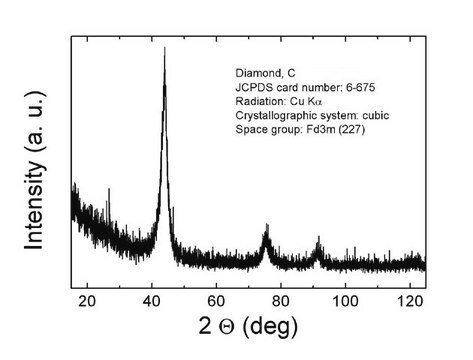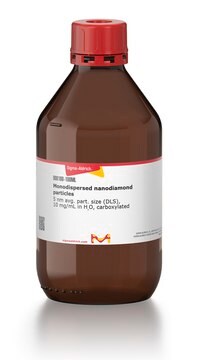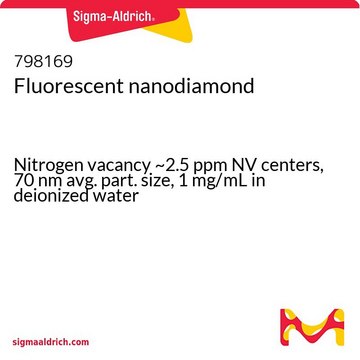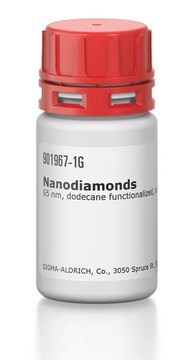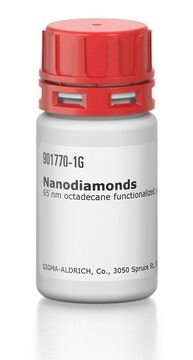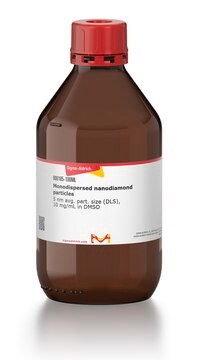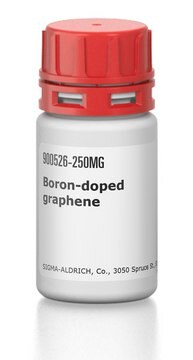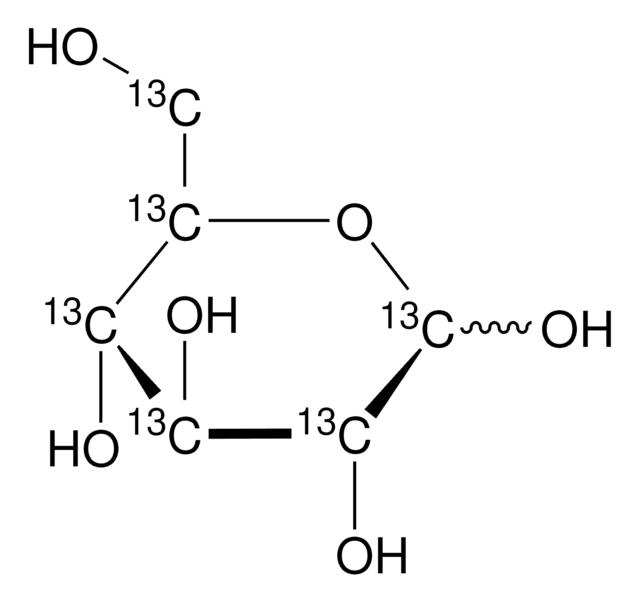636428
Diamant
nanopowder, <10 nm particle size (TEM), ≥97% trace metals basis
Synonym(e):
Diamond dust
Anmeldenzur Ansicht organisationsspezifischer und vertraglich vereinbarter Preise
Alle Fotos(1)
About This Item
Empirische Formel (Hill-System):
C
CAS-Nummer:
Molekulargewicht:
12.01
EG-Nummer:
MDL-Nummer:
UNSPSC-Code:
12352302
NACRES:
NA.23
Empfohlene Produkte
Assay
≥97% trace metals basis
Form
nanopowder
spherical
Oberflächenbereich
200-450 m2/g , BET
Partikelgröße
<10 nm (TEM)
Dichte
3.5 g/mL at 25 °C (lit.)
Schüttdichte
0.2‑0.7 g/mL
Suchen Sie nach ähnlichen Produkten? Aufrufen Leitfaden zum Produktvergleich
Verwandte Kategorien
Allgemeine Beschreibung
The particle size of diamond nanopowder is less than 50 nm and surface area is an average of 100 m2/g. Diamond nanopowder may be produced by multicathode direct current plasma chemical vapor deposition and high pressure high temperature (HPHT). Potential uses of nano-diamond are in biosensor applications. Surface modification of nano-diamond may enhance its linking mechanism with specific biomolecules.
Anwendung
- Insight into Interfacial Heat Transfer of β-Ga(2)O(3)/Diamond Heterostructures via the Machine Learning Potential.: This study explores the interfacial heat transfer in β-Ga2O3/diamond heterostructures, providing critical insights for thermal management in high-power electronics, a key component in the development of efficient energy storage and conversion systems (Sun et al., 2024).
- Impurity characterization in diamond for quantum and electronic applications: advances with time-resolved cathodoluminescence.: The study details advancements in characterizing impurities in diamond, crucial for the development of quantum computing devices and other high-precision electronic applications, using innovative time-resolved cathodoluminescence techniques (Arnold et al., 2024).
- Thermal Conductivity and Sintering Mechanism of Aluminum/Diamond Composites Prepared by DC-Assisted Fast Hot-Pressing Sintering.: Focused on enhancing the thermal management capabilities of materials, this research investigates the thermal properties of aluminum/diamond composites, vital for developing more efficient cooling systems in electronic and energy storage devices (Jia et al., 2024).
Lagerklassenschlüssel
11 - Combustible Solids
WGK
nwg
Flammpunkt (°F)
Not applicable
Flammpunkt (°C)
Not applicable
Persönliche Schutzausrüstung
Eyeshields, Gloves, type N95 (US)
Hier finden Sie alle aktuellen Versionen:
Besitzen Sie dieses Produkt bereits?
In der Dokumentenbibliothek finden Sie die Dokumentation zu den Produkten, die Sie kürzlich erworben haben.
Kunden haben sich ebenfalls angesehen
Thermo-oxidation of tokamak carbon dust.
Davis JW, et al.
Journal of Nuclear Materials, 386, 764-767 (2009)
Reactions of amines with CVD diamond nanopowders.
Lee J K, et al.
Diamond and Related Materials, 14(3-7), 675-678 (2005)
Functionalized diamond nanopowder for phosphopeptides enrichment from complex biological fluids.
Hussain D, et al.
Analytica Chimica Acta, 775, 75-84 (2013)
Pontus Forsberg et al.
Optics express, 21(3), 2693-2700 (2013-03-14)
Control of the sidewall angle of diamond microstructures was achieved by varying the gas mixture, bias power and mask shape during inductively coupled plasma etching. Different etch mechanisms were responsible for the angle of the lower and upper part of
P Pereira Nogueira et al.
The Journal of clinical pediatric dentistry, 37(1), 53-57 (2013-01-25)
The aim of the present study was to evaluate hybrid layer thickness of primary molars sectioned with diamond, carbide and ultrasonic CVD burs. The occlusal enamel surfaces often molars were removed and superficial dentin was exposed. Three standardized cavities were
Unser Team von Wissenschaftlern verfügt über Erfahrung in allen Forschungsbereichen einschließlich Life Science, Materialwissenschaften, chemischer Synthese, Chromatographie, Analytik und vielen mehr..
Setzen Sie sich mit dem technischen Dienst in Verbindung.